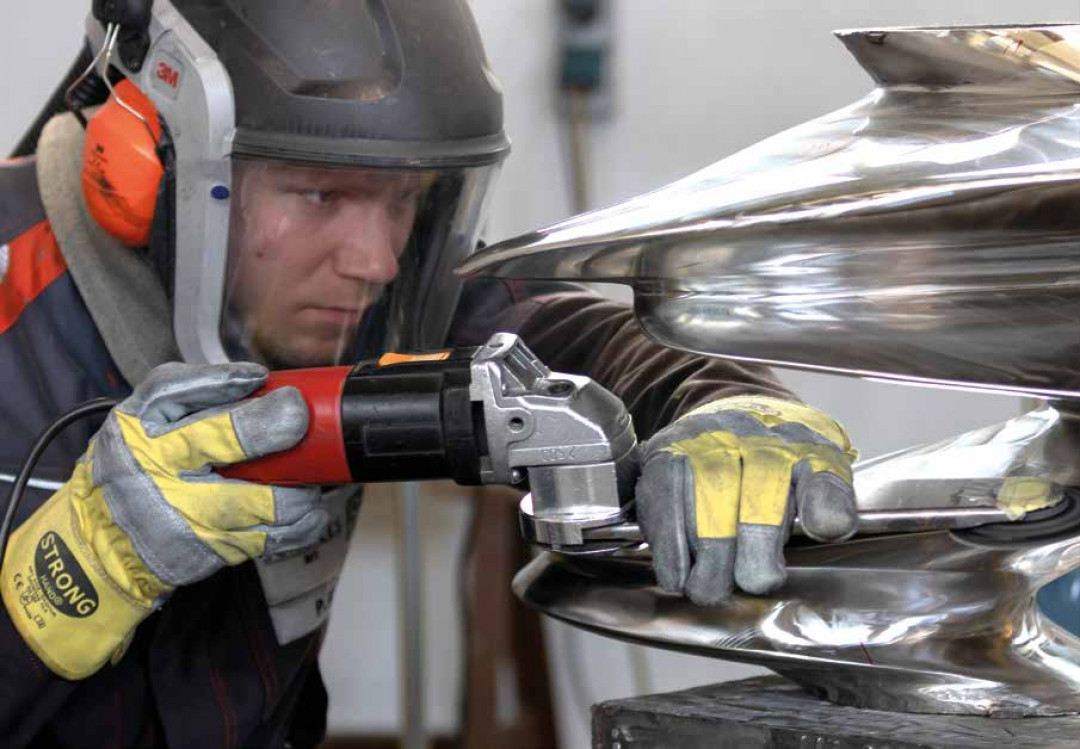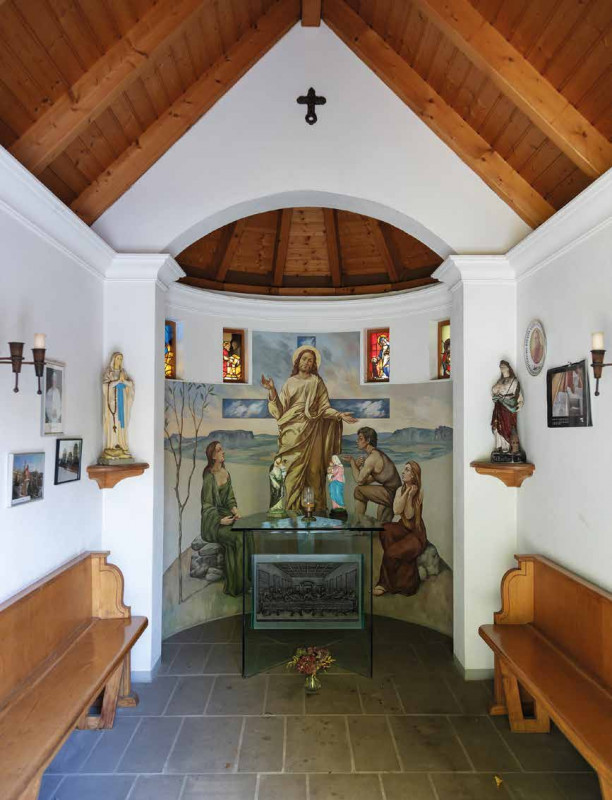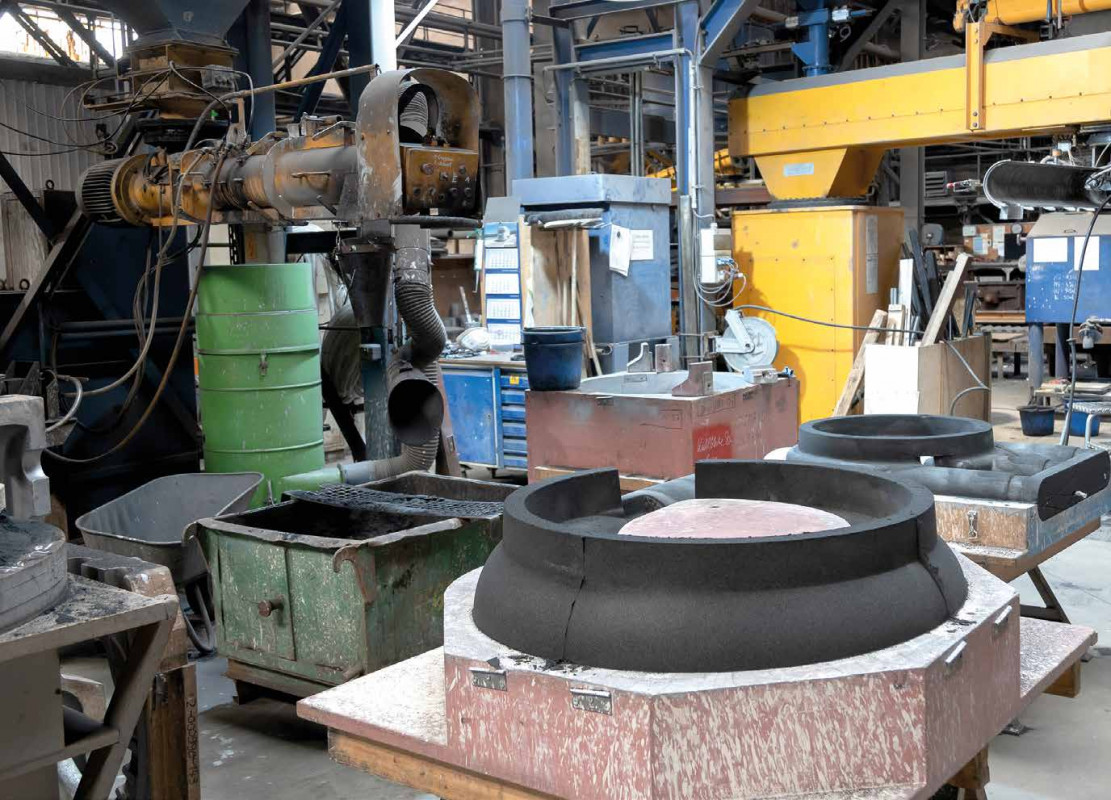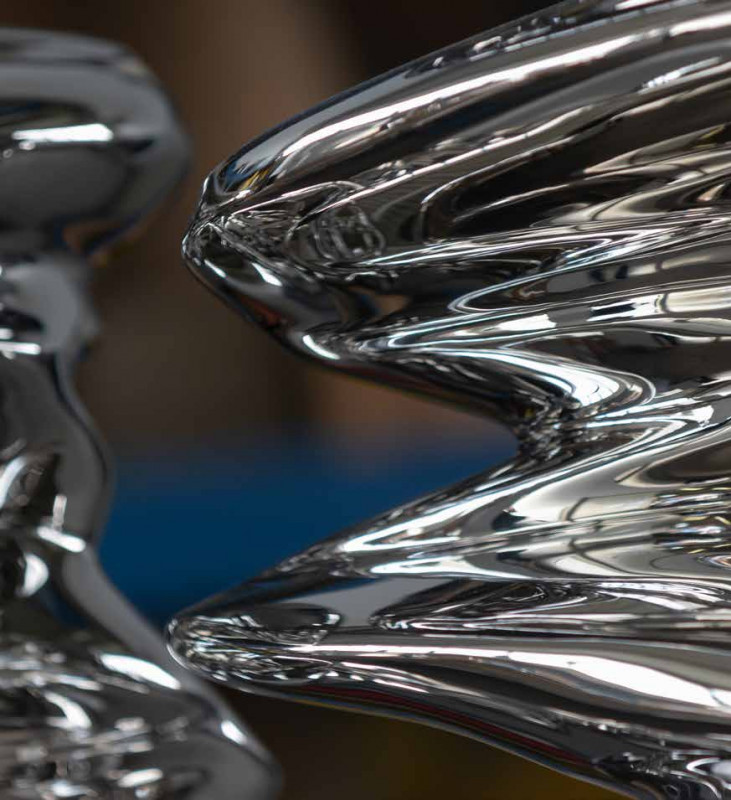

In October 1992, the Schmees family of entrepreneurs bought the Copitz steel foundry in Pirna, Saxony. This 30th anniversary in Pirna was commemorated with an in-house celebration. Today, the site produces workpieces weighing up to seven tons and internationally renowned art casting sculptures.
By Christian Thieme
The panorama window in the administration office offers a fantastic view of the Elbe Valley. It‘s a sunny autumn day with a clear view. Clemens Schmees raises his fi nger and points toward the northwest. „Do you see the vineyard there? That‘s where the famous wine from Pillnitz grows.“ The finger wanders further to the west. „If you look closely, you can still make out the roofs of Dresden‘s old town there on the horizon“.
It is a magical place and as a visitor you immediately understand how the love for this place arises. Pirna is located on the southeastern periphery of Dresden and is divided by the Elbe River. All around you can see forests and the autumn leaves on the trees give off a warm accent of color, inviting you to explore the hiking trails. Pirna is a place where people like to spend their time - the entrepreneurial family sensed this early on. Clemens Schmees also occasionally uses the nearby woods to recharge his batteries while jogging. The Rhinelander has known every nook and cranny here for 30 years now. After reunifi cation, the entrepreneurial family bought what was then the Copitz steel foundry, thus laying the foundation for today‘s company.

The administration building is refl ected in a highly polished stainless steel vase on the forecourt and is located right next to an allotment garden. The modern ambience does not really fit into the otherwise tranquil cityscape. But it does refl ect the soul of the company. Production here is modern, and there is no trace of “Ostalgie” (nostalgia concerning the former German Democratic Republic). Clemens Schmees shows me around the site. Behind the foundry is a small distillery – a dream that the entrepreneurial family has fulfilled over the years. On this day, ripe quinces are distilled. In the anteroom, the entrepreneur points to a corner with shelves full of fine drops. „We are located here in the old administration building, and in this place was my office for a long time“.
We cross the square and stand directly in front of the brewery ‚Brauhaus Pirna – Zum Giesser‘. There is a small chapel in the front garden. „Our Barbara celebration takes place here every year,“ Schmees proudly tells us, adding, „One day before our 30th company anniversary, our granddaughter also got married here.“ The brewery is run by his sister and co-partner Susanne Schmees-Besgen. The brewery welcomes us with its cozy atmosphere. In the middle of the hall is a copper brewing kettle, everything looks modern mixed with old charm. „This was the old social building of the steel foundry Copitz. On our first visit in 1992, it stank terribly here and the porter was busy emptying a dozen buckets because it was raining in everywhere.“ The regulars‘ table is reserved for us today.

Idea for expansion
Clemens Schmees looks into the room: „When we talk about the history of the Pirna site, we have to start with the narrative in the 1980s. In that decade, we introduced the ceramic molding process at our Langenfeld site and completely converted the sand casting process to cold resin. The new manufacturing capabilities enabled us to win pump manufacturers as new customers. At that time we were able to make a good name for ourselves in stainless steel casting, but we were not competitive in normal steel casting. Likewise, investment casting was in high demand, but we were unable to manufacture it.“ The idea arose to expand and then came the German reunification.
In this era, Clemens Schmees and his father Dieter Schmees became aware of an investment casting plant in Pirna that was up for sale. After the initial discussions, however, it quickly became clear that the entrepreneurial family would not get a chance. Via the publication „Alle Gießereien in Ostdeutschland“ (All Foundries in East Germany) – which at the time was published by the forerunner of today‘s Bundesverband der Deutschen Gießerei-Industrie (BDG, Federal Association of the German Foundry Industry) – the entrepreneurial family found the Stahlgießerei-Copitz in Pirna. Dieter Schmees did not hesitate for long and without further ado arranged an appointment with the then Treuhand managing director Jürgen Plattner to visit the site.

A fire united the companies
On April 14, 1992, father and son entered the company premises on Basteistraße for the first time. „It was raining and, apart from the gatekeeper and Mr. Plattner, all 59 employees were on short-time work,“ recalls Clemens Schmees. The first conversation took place in the office of the old administration building.
The subsequent tour showed a quite modern foundry hall. Molding was done in bentonite water glass, on a machine and by hand. Two electric arc furnaces were used as melting units. The shop cranes were equipped with operator cabs and the pattern shop was a dilapidated half-timbered building from 1923. There were no heated shops and a huge fettling machine and two small lathes completed the foundry package. „We went back to Langenfeld with mixed feelings,“ Schmees said. „It looked like we would not buy the site, but the contact with Mr. Plattner had existed since that day.“
Some time later, on a Sunday morning in Langenfeld, the phone rings at the Schmees family‘s home. On the other end, the fire department with the news that the foundry is on fire. „We had a fire in the sand preparation plant,“ the entrepreneur recalls. After the initial damage analysis, it was clear that the business would be shut down for two weeks – a disaster for the company, which had just reached full capacity. To repair the damage more quickly, there was a shortage of locksmiths and electricians. Clemens Schmees picked up the phone, dialed Jürgen Plattner’s number and an hour later six workers from Pirna were in the car heading west. That same evening, the work began as a team. Schmees: „Between 3 and 4 o‘clock on Tuesday morning, we got the message ‚The foundry is running again‘. After that, it was clear that we complemented each other well.“
expanded as a know-how transfer in the Rhineland. Over the summer, production was run in two shifts, and in June and August the company achieved record sales. The intensive cooperation linked the two sites more and more until the purchase agreement was signed on October 13, 1992, in what is now the Brauhaus. „Just one day later, every employee had a job here again,“ says Clemens Schmees.
The site in transition
In the early days, the focus was on productively transforming the site. The first simple models were moved from Langenfeld to Pirna, and the cranes, buildings and roofs were refurbished. Likewise, an induction furnace ordered for Langenfeld was unceremoniously set up in Pirna. „Here we lacked the knowhow to produce stainless steel, and we had to build up the extensive metallurgical knowledge here first. I was still involved in the first batch here at the induction furnace myself,“ states Schmees.
„As nice as that sounds, these decisions also led to resentment among the workforce in the Rhineland. People were suddenly afraid that production would be relocated in its entirety to eastern Germany. As you can see today, we have coped well with this.“ For example, the company‘s headquarters were relocated from Langenfeld to Pirna, and part of the entrepreneurial family also feels at home there.
In 1994, the Pirna site became the first foundry in eastern Germany to receive DIN EN ISO 9001 certification – another important milestone that led to more high-quality customers. In 1996 Johann Unglaub joined the company, who still manages the business today and is now also a shareholder. 1997 saw the first major order for one million German marks. Schmees recalls, „It was twelve turbine housings, each weighing over 7 tons, that went to China.“ „We had a real spirit of optimism here in Pirna,“ adds Johann Unglaub, who has joined the conversation in the meantime.
„At that time, we benefited from the pump business on the one hand, but also from the power plants that were built here in the east. We had quickly established a good reputation with the pump manufacturers.“ Over the years, the company continued on its successful course. The single-shift operation grew into a three-shift operation, quality demands increased and materials know-how continued to develop. Today, the sites are well positioned. In Pirna, the large workpieces up to about 7 tons are produced, and in Langenfeld parts up to a unit weight of 1 ton are produced.
When art entered the company
Shortly after the turn of the millennium, the first work of art was created in Pirna. No one could have imagined at the time that this would later become a passion and a new line of business. „Through art, we started with 3D printing – empirical values that we transferred to industrial casting and from which we still benefit today,“ explains Unglaub.
„We reached another milestone in 2010 when we were able to win Tony Cragg as an artist. We gained experience not only in dealing with complicated undercuts, but also in polishing the surfaces to a high gloss,“ adds Schmees. Many artists followed suit, and well over 200 works of art are now scattered around the world. Clemens Schmees reveals, „The next artwork is already finished and will soon be set up in Dallas, USA.“ 30 years after the takeover, the Saxon company with the Rhineland soul is confidently looking ahead.
„It is remarkable what has happened here in the last thirty years. Over 100 young people have completed their training here and we currently employ around 160 people from 15 nations. In total, we have invested around 34 million euros here at the site.“ Clemens Schmees lets his gaze wander through the brewery: „Over the years, many more stories have emerged - but I‘ll tell you about them another time.“
You can also find the complete article in the CP+T issue 04/2022.

